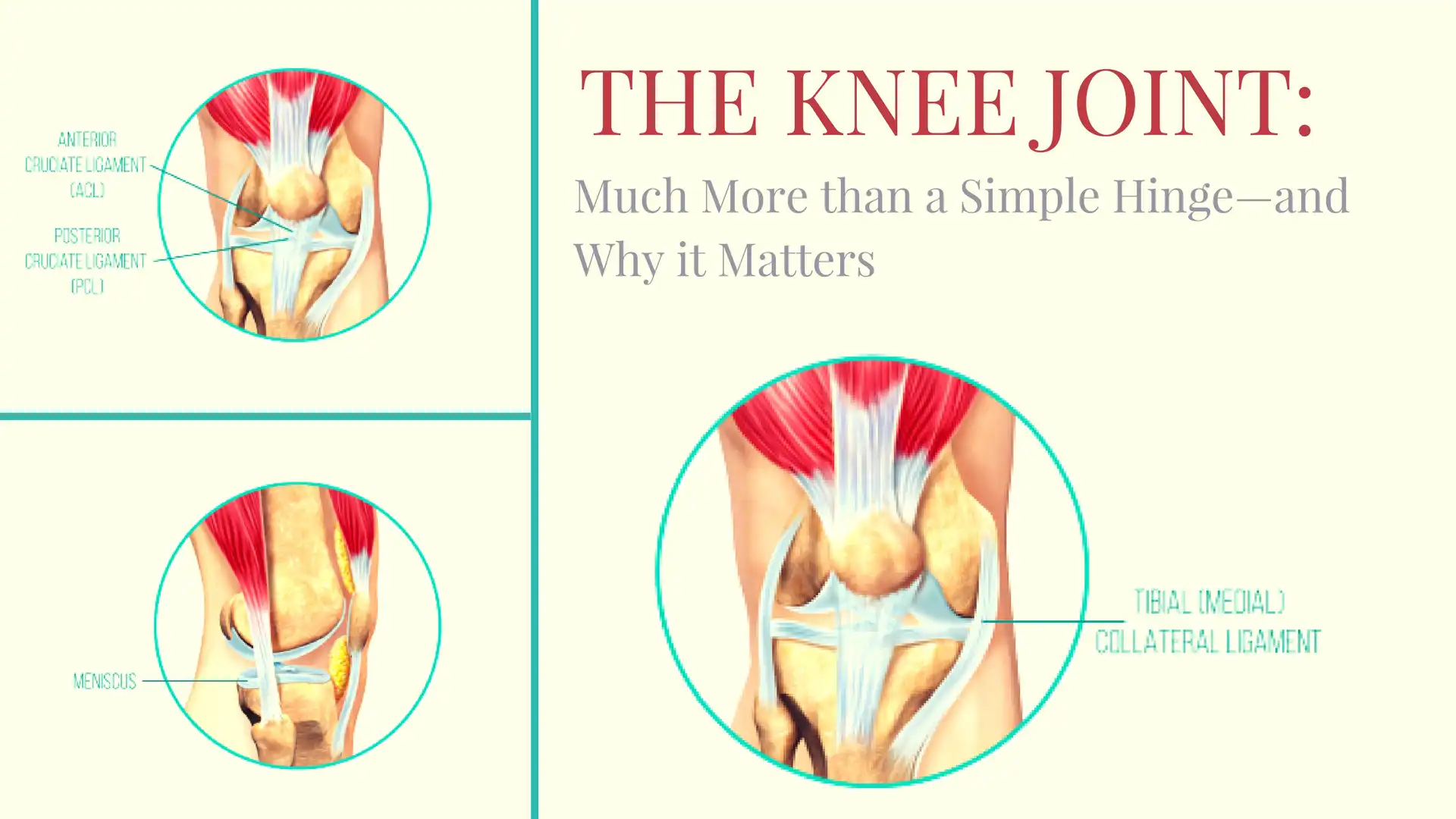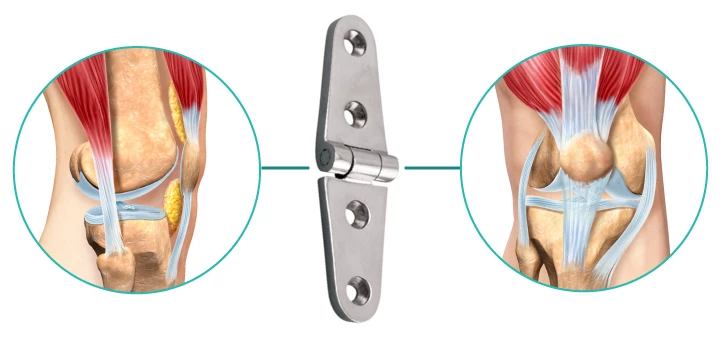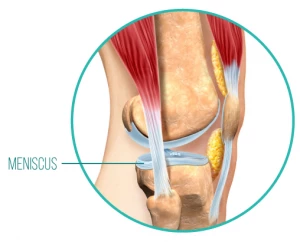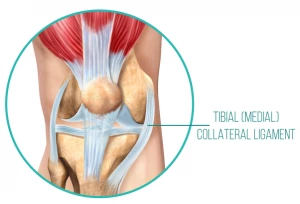The Knee Joint: Much More than a Simple Hinge—and Why it Matters in Your Yoga Practice

According to joints classification, the knee is a “hinge joint” that folds and unfolds like a hinge. Indeed, life would be so much easier for many of us if it were a simple hinge. We would probably have a lot fewer knee problems. A simple hinge would be stable and predictable, moving only one way (fold-unfold) and keeping the top part perfectly aligned with the bottom part.
Mother Nature, in her infinite wisdom, made it a bit more complicated to broaden our movement potential (which came at the expense of stability).

Here is how the knee joint is different from a simple hinge and what it means for our yoga practice.
The knee joint allows for flexion and extension (when you bend the knee and then straighten the leg) but also a little bit of rotation. This means that when you are attempting to fold yourself into Eka Pada Rajakapotasana (Pigeon Pose), Padmasana (Lotus Pose), or any other “hip opening” position that involves external hip rotation, your knee would be happy to help and rotate a bit as well.
The problem is that if your hips do not want to rotate, but you keep leaning into the pose using body leverage, the knee, in its willingness to help, can get hurt since it has very little rotation potential. So the crisscross ligaments between the top and bottom bones of the leg—called anterior cruciate ligament (ACL) and posterior cruciate ligament (PCL)—are designed to stabilize the position between the two can get injured. And just like any other ligament injuries, they are very slow to heal (if they heal at all, they might require eventual surgery to repair them).
4 Ways to Protect Your Knee Joints in Yoga Practice
- Always warm up your hips extensively with movement before holding any strong hip openers (never start your practice with Pigeon Pose or Gomukhasana (Cow Face Pose)!
- Pay close attention to the position and sensations in your knees when doing hip openers if you feel anything at all in your knees, back off.
- Do not use body leverage to lean into a challenging position unless you are sure that your knee feels supported and secure and all the action is happening in the hip.
- Back off from hip-opening poses if you have knee issues and instead focus on movements that strengthen the muscles that support the knee.
The contact surface between the knee bones is always changing. The bony protrusions between the top leg bone (femur) and bottom leg bone (tibia) fit perfectly together (like Legos) only when the leg is perfectly straight. But when you bend the knee, the way they slide against each other changes constantly and depends on the positioning of those bones. For example, keeping the feet together, hip distance apart, or wide apart for squatting positions (in Utkatasana (Fierce Pose) or a wide-legged forward bend, for example) will change the points of contact.
Between those bones lie pieces of cartilage (called “meniscus,” plural “menisci”). Occasionally, the cartilage can get irritated, crack, tear, or fragment, which can cause knee pain. Meniscus tears are usually caused by impact or sudden leg twists in sports, such as football, soccer, or basketball. Still, the meniscus can also become inflamed from continuous pressure (for example, from being overweight). Both tears and irritation can happen at different parts of the meniscus. The outer part, called “the red zone,” has a better blood supply and can potentially heal on its own. The inner part, called “the white zone,” does not have a good blood supply, and tears there might require surgery.
leg twists in sports, such as football, soccer, or basketball. Still, the meniscus can also become inflamed from continuous pressure (for example, from being overweight). Both tears and irritation can happen at different parts of the meniscus. The outer part, called “the red zone,” has a better blood supply and can potentially heal on its own. The inner part, called “the white zone,” does not have a good blood supply, and tears there might require surgery.
How to Protect Your Meniscus in Yoga Practice
- Meniscus tears are often the result of an accident, so you cannot foresee that. But you can maintain the strength of the surrounding musculature of the knee to make sure that your knees have adequate support. This means that you need to do standing yoga poses regularly, including the ones where your feet bear weight with legs straight AND with the knee(s) bent. Maintain good knee alignment.
- If certain standing positions hurt your knees, you can experiment with changing the position of your feet to change the pressure points within your knee joint. But if the pain is acute, just stop.
- Practice poses that include bending the knees with feet together, hip distance, and wide apart to keep your cartilage healthy and properly lubricated. If some of those positions hurt the knee, don’t do them.
Additional mobility in the knee joint allows for the knees to move in toward the midline of the body even when your feet remain hip-distance apart (“knocked-kneed” position). This happens often in poses like Fierce Pose or  Virabhadrasana 2 (Warrior 2 Pose), causing a “droopy knee.” This can put a strain on the tibial collateral ligament that supports the knee from the inside. This is particularly problematic in weight-bearing positions, since the knee joint is responsible for transferring the weight of the body from the femur (upper leg) to the tibia (lower leg).
Virabhadrasana 2 (Warrior 2 Pose), causing a “droopy knee.” This can put a strain on the tibial collateral ligament that supports the knee from the inside. This is particularly problematic in weight-bearing positions, since the knee joint is responsible for transferring the weight of the body from the femur (upper leg) to the tibia (lower leg).
In fact, the knee often ends up on the receiving end of what is happening above (with the hips) and below (with the feet). The knees are literally caught in the middle. That is why we focus so much on “tracking,” stacking the ankle, knee, and hip joints on top of each other to ensure the best alignment for weight transference.
How to Protect Yourself in Yoga
- In poses like Tadasana (Mountain Pose), keep your feet hip-distance apart. Keeping your feet together is not very stable and causes us to tense the inner thigh muscles, creating an imbalance between the inner and outer hip (which can then travel down to the knee). It is especially pronounced in women since we naturally have wider hips. It is fine to do occasional poses with feet together, but don’t make that your default position.
- Work on balanced development between your adductors (inner thigh muscles) and abductors (outer hip muscles). And don’t forget your iliotibial (IT) band.
- If you notice your knee(s) collapsing inward in Fierce Pose or Warrior 2 Pose, you can either correct it with intentional muscle engagement (pressing the outer edge of the foot down and intentionally moving the knee out in Warrior 2 Pose might help), or with props (putting a light block between the inner thighs in Fierce Pose will help keep your knees in proper position).
- None of these potential issues would be relevant if the knee were a simple hinge joint. In addition, there is this pesky patella (kneecap) that can slide around on top of the knee joint and make it hard for us to get down on the knees or go up or down the stairs.
The good news is that by practicing with care and attention to the principles outlined here, your yoga practice can support healthy knees throughout your life.
More from Olga Kabel-The Broomstick Effect: The #1 Key To Practicing Balancing Postures.
Also, read...
No Muscle Is an Island – Are You Making This Common Strength Training Mistake?
Discovering the Living Body: A Yoga Teacher’s Revolutionary Insight on Fascia
The Fascia Connection: Tom Myers on How Postural Habits Get Locked into Our Fascial System
Related courses

Educated as a school teacher, Olga Kabel has been teaching yoga for over 14 years. She completed multiple Yoga Teacher Training Programs but discovered the strongest connection to the Krishnamacharya/ T.K.V. Desikachar lineage. She had studied with Gary Kraftsow and American Viniyoga Institute (2004-2006) and received her Viniyoga Teacher diploma in July 2006, becoming an AVI-certified Yoga Therapist in April 2011. Olga is a founder and managing director of Sequence Wiz— a web-based yoga sequence builder that assists yoga teachers and yoga therapists in creating and organizing yoga practices. It also features simple, informational articles on how to sequence yoga practices for maximum effectiveness. Olga strongly believes in the healing power of this ancient discipline on every level: physical, psychological, and spiritual. She strives to make yoga practices accessible to students of any age, physical ability, and medical history, specializing in helping her students relieve muscle aches and pains, manage stress and anxiety, and develop mental focus.



